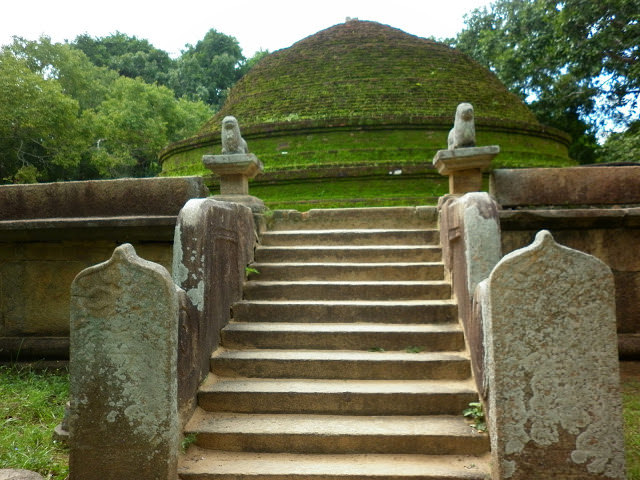OB03151 Rāssahela Inscribed Boulder
Buddhist ruins at Rajagala, Ampara District, Eastern Province
IN03190 Rāssahela Rock Inscription 1
This inscription is engraved on the side of a boulder among the remains of an extensive ancient monastery on the rocky hill called Rājagala or Rāssahela in the Vävugam Patty of the Batticaloa District. A cave is formed underneath the boulder and there are a total of four inscriptions on the side of the rock. The present inscription records a grant of lands by an individual called Sen – probably a local ruler of Rohaṇa – to a monastery called Arittāra-vehera, which was undoubtedly the ancient name of the monastery at Rāssahela. It is not possible to connect the donor named in the present inscription with any known historical personages but the inscription can be dated on palaeographic grounds to around the second half of the eighth century A.D. Two of the other inscriptions on the boulder (IN03191 and IN03192) are also concerned with land-grants to the monastery and, from their palaeography, they appear to date from the same period as the present inscription. Furthermore, the donor named in one of these inscriptions (IN03192) can be identified with a prince mentioned in the Mahāvaṁsa as having been alive in the reign of Udaya I, who ruled for five years from around 787. This historical evidence helps to confirm the dating of these three inscriptions to the eighth century. Only traces survive of the fourth inscription on the boulder, which seems to have a slightly later date.
OB03150 Magul-maha-vihāra Fragmentary Pillar of Vihāra-mahā-devī
Magul Maha Viharaya, Lahugala
IN03189 Magul-maha-vihāra Fragmentary Pillar Inscription of Vihāra-mahā-devī
This fragmentary inscription is engraved on three sides of a broken stone pillar found among the ruins of an ancient monastery situated in the Pānama Pattu of the Batticaloa District, about a mile to the south of the eighth mile-stone on the road from Potuvil to Vällavāya. The ancient name of this monastery was Rūṇu-maha-vehera; it is now known as Magul-maha-vihāra. The upper half of the pillar has been broken off and lost, resulting in the loss of large parts of the inscription. The record can be dated, on palaeographic grounds, to the fourteenth century. The extant portion of the inscription records that Rūṇu-maha-vehera, the ancient monastery at the site, was completely renovated by Vihāra-mahā-devī, the consort of the two brother kings named Parākramabāhu, after it had fallen into ruin and that she endowed it with lands for its maintenance. It seems that the inscription originally included a detailed account of the successful campaign fought by the brother kings after the Coḷa army but the inscription is mutilated just at the point where the reference to this historical event begins. The pillar was apparently set up after the demise of these kings, since the inscription tells us in the past tense that Vihāra-mahā-devī ‘was the chief consort of the two brother kings’. Since these brothers are described as ruling over Rohaṇa in another inscription found at Magul-maha-vihāra (IN03188), it seems likely that they were local princes whose authority was confined to this region, rather than paramount sovereigns of Sri Lanka.
OB03149 Magul-maha-vihāra Slab of Vihāra-mahā-devī
Magul Maha Viharaya, Lahugala
IN03188 Magul-maha-vihāra Slab Inscription of Vihāra-mahā-devī
This inscription is engraved on a stone slab found to the left of the flight of steps at the entrance to a ruined structure on the site of an ancient monastery situated in the Pānama Pattu of the Batticaloa District, about a mile to the south of the eighth mile-stone on the road from Potuvil to Vällavāya. The ancient name of this monastery was Rūṇu-maha-vehera; it is now known as Magul-maha-vihāra. The present inscription can be dated, on palaeographic grounds, to the fourteenth century. It is written as a palimpsest over a long tenth-century inscription which has thus been obliterated, save for thirteen lines at the end. The later inscription records that Rūṇu-maha-vehera, the ancient monastery at the site, was completely renovated by Vihāra-mahā-devī, the consort of the two brother kings named Pärakumbā, after it had fallen into ruin and that she endowed it with lands for its maintenance. Since these brothers are described in this inscription as ruling over Rohaṇa, it seems likely that they were local princes whose authority was confined to this region, rather than paramount sovereigns of Sri Lanka.
OB03147 Anurādharpura Smaller Stone Canoe
IN03186 Anurādharpura Stone Canoe Inscription
This inscription is engraved on the smaller of the two stone canoes found in the vicinity of the ‘Stone Canopy’ (Burrows’ Pavilion) in the area of the Abhayagiri Vihāra at Anurādharpura. It consists of three lines and can be dated on the basis of the palaeography to the latter half of the eighth century or the beginning of the ninth century. The purpose of the inscription is to state that the stone canoe was the gift of a novice (sāmaṇera) named Gonnā.
OB03146 Tammannǟgala Moonstone
IN03185 Tammannǟgala Moonstone Inscription
This inscription is engraved round the edge of a moonstone placed at the bottom of a flight of steps leading to the dāgäba at an old vihara called Tammannǟgala in the Nǟgampaha Kōraḷē of the Anurādhapura District. It was first noticed for scholarship by H. C. P. Bell in the Archaeological Survey of Ceylon Annual Report for 1895 (p. 7, no. 14). Bell dated the inscription to the ninth century but Senarath Paranavitana argued on the basis of the palaeography for an earlier date, sometime between the reigns of Kassapa III (r. 732–738 A.D.) and Sena I (r. 846–866 A.D.). The inscription states that the moonstone on which it is engraved was a gift of a person named Valjeṭu of Piḷiyāna.

